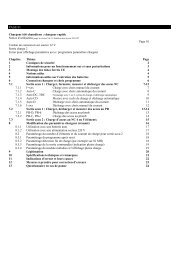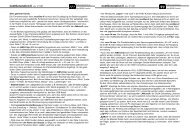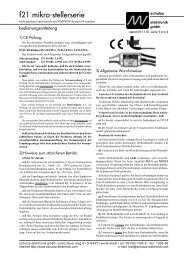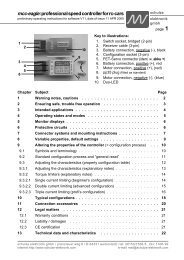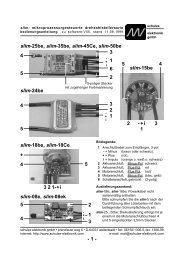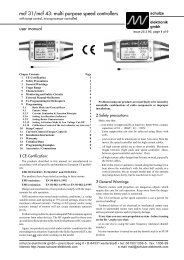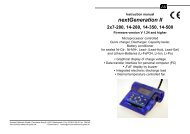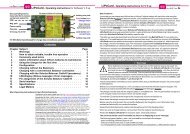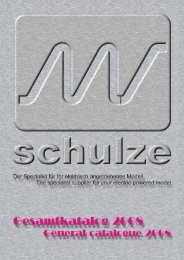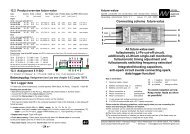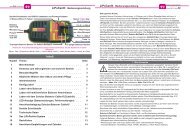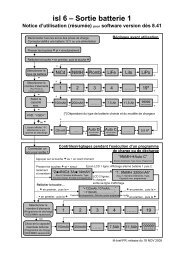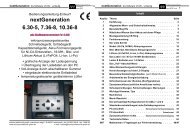ecolader: rapid discharger/charger series - Schulze Elektronik GmbH
ecolader: rapid discharger/charger series - Schulze Elektronik GmbH
ecolader: rapid discharger/charger series - Schulze Elektronik GmbH
Create successful ePaper yourself
Turn your PDF publications into a flip-book with our unique Google optimized e-Paper software.
<strong>ecolader</strong>: <strong>rapid</strong> <strong>dis<strong>charger</strong></strong>/<strong>charger</strong> <strong>series</strong><br />
Operating instructions for software V1.04, date of issue 05 MAY 1998<br />
battery 3:<br />
Max. charge time 50 min<br />
Max. charge quantity 1000 mAh<br />
Termination temperature 45° C<br />
Termination delay 8 min<br />
Termination check count 3 x<br />
Termination sensitivity 1mV/cell<br />
Termination criterion Peak<br />
Charge method Linear charge<br />
Max. charge current 1 A<br />
Charge / discharge program Fix C<br />
Max. discharge current 1 A<br />
Final discharge voltage automatic<br />
Cycle count of combination program 1<br />
Program after POR Fix C<br />
special:<br />
Max. primary current 20 A<br />
Min. car battery voltage (Umin.) 11.2 V<br />
Light flashing<br />
Buzzer on<br />
LCD mode One-Batt-Screen<br />
Display / select default settings:<br />
Press enter to accept default setting<br />
(screen shows: "executed")<br />
Press esc to interrupt.<br />
8.22 Max. primary current<br />
schulze<br />
elektronik<br />
gmbh<br />
Page 25<br />
Description:<br />
This function avoids your car battery being overloaded<br />
(when the voltage falls to an unacceptable<br />
level); can also be used to prevent overloading<br />
a mains PSU.<br />
Mains PSUs may only be operated within their<br />
stated continuous load capacity (the lower value<br />
in the specification for the PSU) which is specific<br />
to that unit.<br />
If you ignore this, there is a danger that the<br />
mains PSU will overheat, or its output voltage will<br />
collapse under severe load. As a rule the <strong>ecolader</strong><br />
carries out a Reset in this situation, i.e. it<br />
acts as if it had just been connected to the car<br />
battery, and then "hangs" at the self-test stage<br />
since batteries are already connected to it.<br />
In the worst case the <strong>ecolader</strong> may "hang" at full<br />
charge current, and in this situation it is very likely<br />
to wreck your valuable batteries.<br />
You can avoid such a disaster by setting an input<br />
current (primary current) which suits your mains<br />
PSU, i.e. you limit the <strong>ecolader</strong>'s current drain.<br />
Bear in mind that the <strong>ecolader</strong> itself consumes a<br />
small idle current, and this must also be included<br />
in the calculation.<br />
Also remember that a limit placed on the primary<br />
current means that the full level of current pulses<br />
will not be achieved if you use pulsed charging.<br />
Method of working:<br />
If the permissible primary current is exceeded,<br />
the charge current is reduced to a lower value.<br />
If several batteries are connected to the unit, the<br />
current to all batteries is reduced equally.<br />
Any current reduction is only restored when you<br />
disconnect a battery.<br />
Any current reduction is not restored when a battery<br />
reaches the fully charged stage.<br />
The current does not change if a battery is at the<br />
"full detection" stage (a, b ... on the screen). If<br />
you connect a new battery at this stage, the battery<br />
<strong>charger</strong> ignores it initially!<br />
Activating the menu point<br />
Press the spezial button<br />
Select:<br />
Press the + or - button<br />
Select range:<br />
5 A ... 20 A ... 22 A<br />
Confirm select, or interrupt:<br />
Press enter or esc<br />
Note:<br />
A reduction in primary current manifests itself in<br />
particular when you select pulsed charging, as<br />
the unit then limits the peak current drain instead<br />
of the average current drain.<br />
schulze elektronik gmbh • prenzlauer weg 6 • D-64331 weiterstadt • tel: 06150/1306-5, fax: 1306-99<br />
internet: http://www.schulze-elektronik.com e-mail: mail@schulze-elektronik.com



